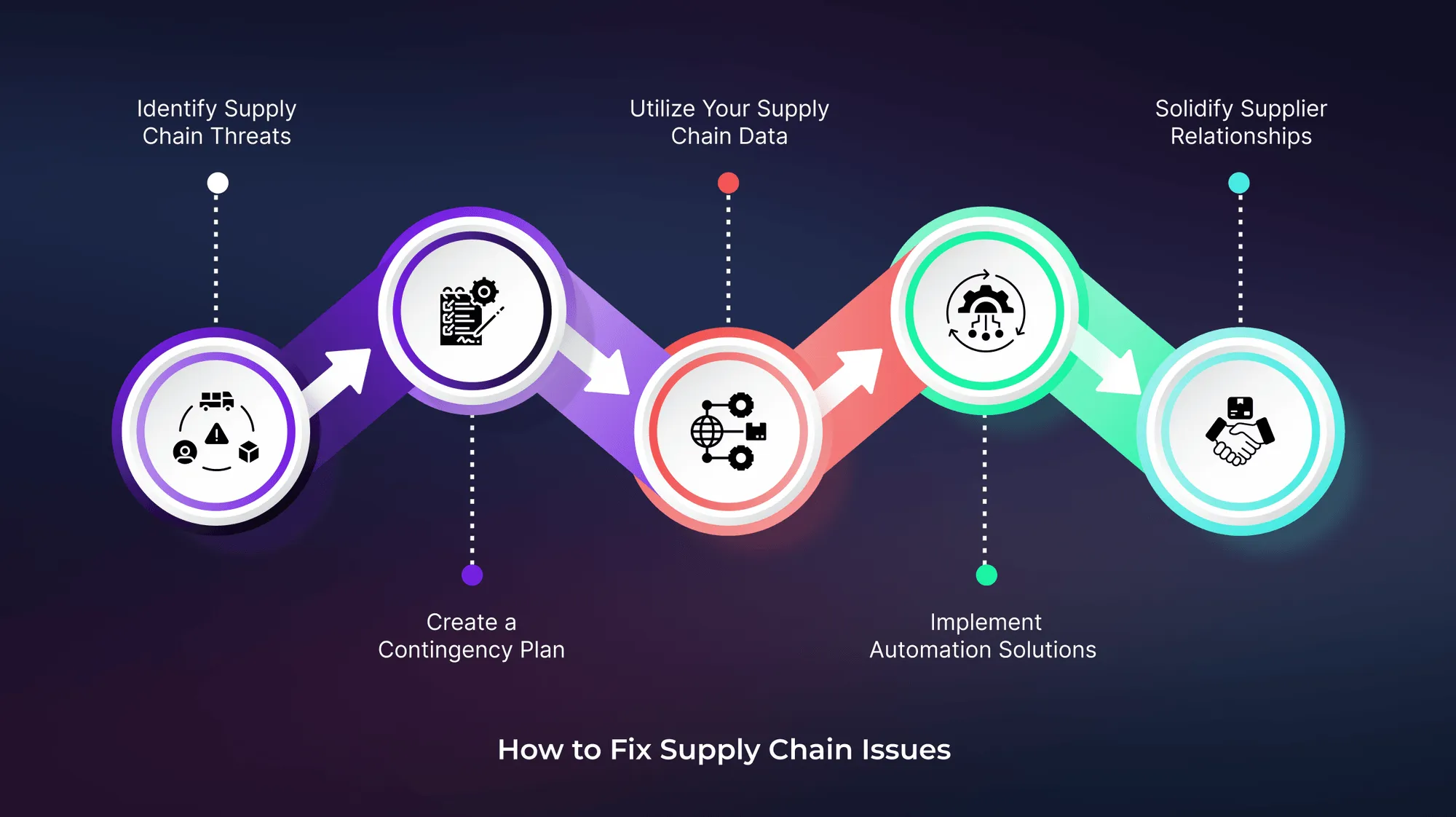Supply chain issues have presented significant business challenges for e-commerce and retail businesses in recent years. This disruption is forcing global supply chains and companies to rethink their strategies. Despite improvements, new challenges persist. Current supply chain issues include port congestion, limited labor mobility, production delays, rising fuel costs, increased freight prices, and severe weather events like hurricanes, tornadoes, and wildfires.
What’s worse? The situation has been exacerbated by increasing consumer expectations for faster delivery and unique products, making it crucial for businesses and supply chain companies to build resilient, flexible supply chain networks that can be ‘antifragile’ while maintaining smooth operations. In this article, we’ll explore these supply chain issues and how to fix them in detail.
Overview of Recent Supply Chain Disruptions
If you’re wondering why there is a supply chain issue, let’s look in retrospect. In 2021 and 2022, global supply chains saw some recovery after the 2020 supply chain disruption, but several eCommerce supply chain challenges persisted. Unexpected disruptions—such as new COVID-19 variants, factory shutdowns, and the blockage of the Ever Given (a large container ship) in the Suez Canal in March 2021—added to the difficulties.
The Russia-Ukraine conflict has led to higher energy prices and flight restrictions in the region, making it more challenging and costly for brands to ship and source products from China and Europe. These disruptions have impacted supply chains, forcing companies to adapt their supply chain strategies to navigate the increased expenses and limitations in transportation options.
Despite these hurdles, many e-commerce brands found creative solutions. Some turned to selling products on backorder, while others shifted to working with domestic suppliers instead of relying on international partners. These strategies didn’t completely resolve supply chain problems but helped businesses stay competitive and maintain revenue during a highly challenging and unpredictable period.
What Are the Biggest Supply Chain Issues Today?
Let’s now answer ‘what are the current issues in supply chain?’ and try to understand the causes of supply chain disruption:
- Inflation Impact: Global inflation is affecting costs for labor and raw materials, prompting companies to adjust payment strategies and manage product lines to maintain profitability.
- Evolving Consumer Expectations: Post-pandemic, consumers demand faster delivery times and enhanced customer experiences.
- Rising Shipping Costs: Increased fuel prices and labor costs, alongside conflicts affecting key shipping routes, have led to higher freight costs and longer transit times.
- Port Congestion Risks: While port congestion has improved, labor shortages and potential job actions could still disrupt loading and unloading processes.
- Inventory Management Struggles: Insufficient historical data makes accurately forecasting demand challenging. Therefore, businesses rely on intuition rather than data-driven analysis.
How to Fix Supply Chain Issues
There are plenty of strategies you can implement to keep your inventory stocked and your business thriving. Here are some effective solutions:
Identify Supply Chain Threats
Supply chain planning requires identifying possible risks before they disrupt your business. Disruptions frequently originate within supply chain procurement or other areas of management. Factors like natural disasters, labor strikes, or global events can halt operations. Evaluate your current shipping routes, supplier reliability, and global economic factors to understand where your business could face potential disruptions.
Create a Contingency Plan
Once you’ve figured out what supply chain issues are for your business, once you’ve identified risk factors, the next step is creating a strong contingency plan. Consider alternative shipping ports, such as backup routes, that can be used if your primary options are blocked or congested. You can also work with freight forwarders to help ensure your goods keep moving, even during unexpected delays. A flexible line of credit can also help you react quickly to increased shipping costs or inventory shortages, ensuring your business stays on track.
Utilize Your Supply Chain Data
Data plays a critical role in maintaining a smooth supply chain. Real-time insights into demand, inventory levels, and shipping status can help you stay one step ahead of potential issues. Automated forecasting tools, for example, allow you to adjust your inventory based on historical sales trends, helping you avoid stockouts or overstocking. By monitoring your supply chain data closely, you can predict and manage disruptions more effectively.
Implement Automation Solutions
Automation is key to creating an agile supply chain. From automated inventory management to real-time order tracking, these tools can help streamline supply chain logistics and respond faster to changes in demand or shipping challenges. In times of crisis, automated solutions provide supply chain visibility, allowing for quicker decision-making and reducing the chances of human error.
Solidify Supplier Relationships
Diversifying and maintaining strong relationships with suppliers is essential for minimizing risks. Especially for a manufacturing supply chain, instead of relying on a single supplier, it’s important to work with multiple partners to ensure flexibility. In case one supplier experiences delays or supply chain bottlenecks, you’ll have alternatives in place. Building trust and collaboration with suppliers also encourages open communication, which can help you navigate challenges more effectively when they arise.
Preparing for Future Supply Chain Issues
The ongoing supply chain industry issues, particularly in raw materials like industrial metals, will continue to affect various sectors, including automotive and construction. Inflation rates are dampening consumer spending, so demand for imported goods and high-ticket items may decline. However, supply chain improvements in 2024, such as falling gas prices and enhanced automation technologies, indicate progress in supply chain trends. Many brands are taking proactive measures to strengthen their global supply chains by adopting new technologies, increasing inventory levels, and diversifying product sources. The lack of stockpiling inventories could pose risks if demand surges unexpectedly. As these economic factors evolve, businesses should stay vigilant and adapt to ensure sustainable growth and meet consumer expectations.
How PackageX Streamlines Supply Chain Operations
PackageX tackles supply chain challenges with dynamic pricing, AI-driven inventory management, and cost-effective supply chain solutions. AI and machine learning are necessary tools for accurate demand forecasting and integrating historical data with market trends to enhance inventory management. Our real-time port management offers congestion updates and expedited customs clearance. The cloud-based platform’s integration supports seamless system connections and IoT-based asset tracking, providing businesses with scalable, efficient operations.
{{returns-webinar}}
FAQs
What are the critical issues in the supply chain?
The supply chain challenges include unpredictable consumer demand, rising shipping costs, long lead times, finding reliable carriers, managing risks, labor shortages, delayed port operations, and staying updated with technology.
Why are there so many supply chain issues right now?
The causes of the recent supply chain challenges are rapid inflation, geopolitical tensions, severe weather, and the COVID supply chain disruption.
What are 3 emerging supply chain technologies?
Three emerging supply chain technologies are IoT (Internet of Things), AI (Artificial Intelligence), and blockchain. These allow for real-time monitoring, automation, and predictive analytics to make better decisions.
What is the financial impact of supply chain disruption?
Supply chain disruptions can negatively impact a company’s financial health. This leads to reduced revenue and operating income, which results in higher overall inventory levels and increased total costs, putting additional pressure on the business.




